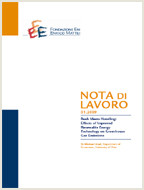Crime and Education in a Model of Information Transmission

01.10.2010
Darwin Cortés, Guido Friebel, Darío Maldonado
D82, D83, I28
Human Capital, The Economics of Rumors, Social Interactions, Urban Economics
Economy and Society
Gianmarco I.P. Ottaviano
We model the decisions of young individuals to stay in school or drop-out and engage in criminal activities. We build on the literature on human capital and crime engagement and use the framework of Banerjee (1993) that assumes that the information needed to engage in crime arrives in the form of a rumor and that individuals update their beliefs about the profitability of crime relative to education. These assumptions allow us to study the effect of social interactions on crime. We first show that a society with fully rational students is less vulnerable to crime than an otherwise identical society with boundedly rational students. We also investigate the spillovers from the actions of talented students to less talented students and show that policies that decrease the cost of education for talented students may increase the vulnerability of less talented students to crime. This is always the case when the heterogeneity of students with respect to talent is sufficiently small.
